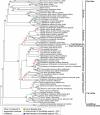Resolving the evolution of extant and extinct ruminants with high-throughput phylogenomics
- PMID: 19846765
- PMCID: PMC2765454
- DOI: 10.1073/pnas.0904691106
Resolving the evolution of extant and extinct ruminants with high-throughput phylogenomics
Abstract
The Pecorans (higher ruminants) are believed to have rapidly speciated in the Mid-Eocene, resulting in five distinct extant families: Antilocapridae, Giraffidae, Moschidae, Cervidae, and Bovidae. Due to the rapid radiation, the Pecoran phylogeny has proven difficult to resolve, and 11 of the 15 possible rooted phylogenies describing ancestral relationships among the Antilocapridae, Giraffidae, Cervidae, and Bovidae have each been argued as representations of the true phylogeny. Here we demonstrate that a genome-wide single nucleotide polymorphism (SNP) genotyping platform designed for one species can be used to genotype ancient DNA from an extinct species and DNA from species diverged up to 29 million years ago and that the produced genotypes can be used to resolve the phylogeny for this rapidly radiated infraorder. We used a high-throughput assay with 54,693 SNP loci developed for Bos taurus taurus to rapidly genotype 678 individuals representing 61 Pecoran species. We produced a highly resolved phylogeny for this diverse group based upon 40,843 genome-wide SNP, which is five times as many informative characters as have previously been analyzed. We also establish a method to amplify and screen genomic information from extinct species, and place Bison priscus within the Bovidae. The quality of genotype calls and the placement of samples within a well-supported phylogeny may provide an important test for validating the fidelity and integrity of ancient samples. Finally, we constructed a phylogenomic network to accurately describe the relationships between 48 cattle breeds and facilitate inferences concerning the history of domestication and breed formation.
Conflict of interest statement
The authors declare no conflict of interest.
Figures



References
-
- Foss SE, Prothero DR. Introduction to The Evolution of Artiodactyls. In: Foss SE, Prothero DR, editors. Baltimore, MD: Johns Hopkins University Press; 2007. pp. 1–3.
-
- Gatesy J, Yelon D, DeSalle R, Vrba ES. Phylogeny of the Bovidae (Artiodactyla, Mammalia), based on mitochondrial ribosomal DNA sequences. Mol Biol Evol. 1992;9:433–446. - PubMed
-
- Marcot JD. Molecular phylogeny of terrestrial artiodactyls: Conflicts and resolution. In: Foss SE, Prothero DR, editors. The Evolution of Artiodactyls. Baltimore, MD: Johns Hopkins University Press; 2007. pp. 4–18.
Publication types
MeSH terms
Substances
LinkOut - more resources
Full Text Sources
Other Literature Sources

